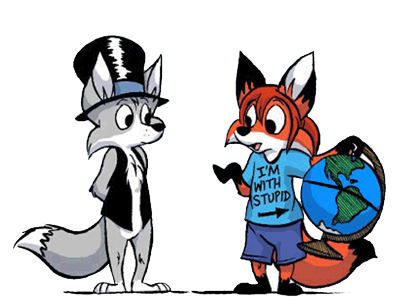Member of the genus Pteropus, or at least within the order Megachiroptera?the mild difficulty in classifying a flying fox.
Otter or Human?
Moderator:Æron
-
Richard K Niner
- Posts:4297
- Joined:Wed Oct 20, 2004 5:08 pm
- Location:On hiatus
- Contact:
...Vulpes Draco is what I think of my nomenclature, though I'm sure you could find at least one specialist who disagrees.For simplicity's sake, yes. On an earlier version of the forum, when we could have a few words right underneath our usernames, I put, "Screeching bat/primate/confused canid," in reference to the mild difficulty in classifying a flying fox.I think Tom Flapwell is a bat
Oh. You mean flying fox the species, not flying fox as in 'foxes that can fly'. Fair enough.
Livejournal, GreatestjournalSirQuirkyK: GSNN argued that Unanonemous is to sociologists what DoND is to statisticians
Gizensha Fox: ...Porn?
- Tom Flapwell
- Posts:5465
- Joined:Wed Feb 23, 2005 1:48 pm
- Location:DC
- Contact:
Or you could take the "Boondocks" approach:D'youknowhatImean?
"Knaamean?"
See other much-maligned creatures in my webcomic: http://downscale.comicgenesis.com
Sounds right to me;...Vulpes Draco is what I think of my nomenclature, though I'm sure you could find at least one specialist who disagrees.
(generalized) Vulpes draco - A fox with dragon qualities
(wall of text) Vulpes draco - The specific epithet referring to one Gizensha Fox, seperated thusly into the following constituants of the binomial: Vulpes, or fox, being the Genus, and Species draco, latin for Dragon. Further, these are collectively a part of the Family Canidae, order Carnivora, class Mammalia, of the Phylum Chordata and therefore in the Kingdom Animalia. Additionally, the entire set is part of the superset Domain Eukaryota, which, seperated into it's Greek parts, means Good (ευ) Nut (κάρυον). In this zoological nomenclature system, pioneered by Linnaeus, each successive "grouping" has a broader and broader sense of boundary, as to make the next "grouping" encompass more. In short, you could say that, starting at the Species level and working toward Domain, the names describe something less specific and more inclusive. An example would be of the Canid/ae Family, which doesn't include one Genus, but multiple Genera, such as the two most common: The foxes (genus Vulpes) and the dogs (Genus Canine). Of the dogs, there can be many species that are more specifically defined after all's said and done, such as the coyotes (Species Spra...Species latrans), Gray wolf (Species lupus), Red Wolf (Species rufus), and many others. [Also note that species are lowercase]
To tie this all together, we will extract only a few things from this reading. The second part of the epithet, or the Genus, is a broader definition for an organism, thus it carries with it "more weight". It broadly defines very general qualities that other species share. Since the first part of the zoological biNomial (not related to Klaus Nomi), or the specific epithet [which can refer to either the two part binomial only in zoology, and only if it is referred to only as an epithet, not specific epithet. In botany it is always the specific name, or species], is a more precise declaration, sorting out the minutiae of the broader picture, the Genus, we can conclude that the first word is the major defining word of a species, while the second sorts out smaller details. For reference see the thread in the Fanworks fourm in this site, for the picture in the link labelled "Wood for Sheep" in the post made by the RKNiner in the fifty-third page, and you will see a mostly fox antrhopomorphic character, thus confirming the above Wall of Text (tm)
Did I use enough words to show my intelligence guys
Last edited by Tai on Fri Jul 13, 2007 1:34 am, edited 2 times in total.
Who is online
Users browsing this forum: No registered users and 15 guests


